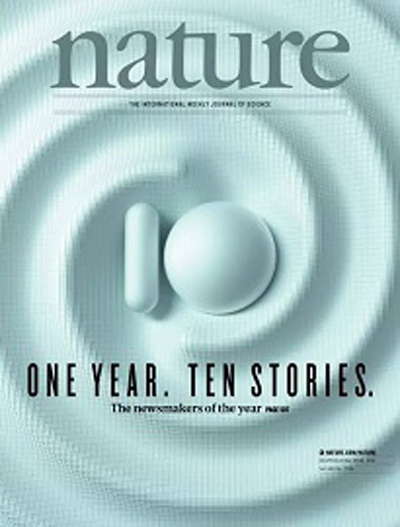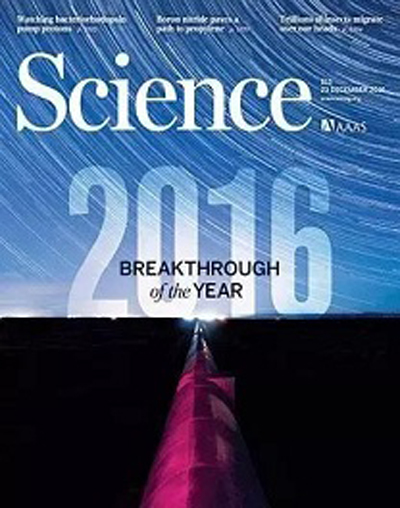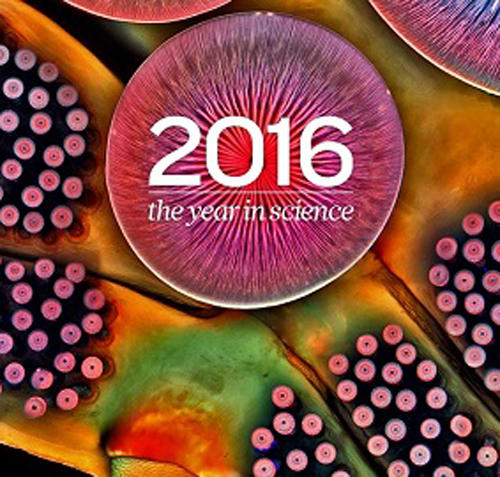

Contact: Manager Yang
Hotline: 950-4048-3964 (free)
Tel: 0510-85386636
Mobile: 18011518665
Shangmeng Technology Wuxi Co., Ltd.
Address: A1-602, Tianan Smart City, No. 228 Linghu Avenue, Xinwu District, Wuxi City, Jiangsu Province
At the beginning of this year, "Nature" and "Science" published two articles on international authoritative academic journals respectively, reviewing the major scientific progress in 2016, the top ten scientific figures, the wonderful scientific photos of 2016, and the 2017 The focus of the global scientific community is on the horizon. Have you achieved it? Let's review it.
1. "Nature" selected the top ten scientific figures of 2016

On December 19th, the British "Nature" magazine website published the top ten scientific figures of the magazine (Nature's 10, DOI: 10.1038/540507a), which summarized the ten people who had a major impact on the scientific community in 2016. This list includes:
Physicist Gabriela Gonzalez, who helped humans first capture gravitational waves;
Demis Hassabis, co-founder of DeepMind, which developed the artificial intelligence "AlphaGo" (AlphaGo)
Terry Hughes, head of the Australian Research Council (ARC) Coral Reef Research Center;
Guus Velders, an atmospheric chemist who has made outstanding contributions to international climate agreements;
Celina M. Turchi, an expert in infectious diseases that proves that the mother is infected with Zika virus and neonatal small head disease within the first 3 months after pregnancy;
Alexandra Elbakyan, founder of Sci-Hub, challenged the traditional science publishing industry by providing about 60 million papers online;
John Zhang, a reproductive geek who often challenges scientific ethics, in October 2016, Zhang Jin team announced the successful use of mitochondrial replacement technology to mix three people's DNA to make a healthy baby boy born, "harvest" Countless criticisms and praises;
Gene-driven biologist Kevin Esvelt using CRISPR-Cas9;
Discover the known astronomer Guillem Anglada-Escudé, the nearest extrasolar planet, Proxima b;
Elena Long, a physicist who paved the way for greater tolerance for minorities.
(integrated online report)
2. Science magazine named the top ten scientific breakthroughs in 2016 and found that the gravitational wave won the championship.
On December 23rd, the US Science magazine published the 2016 Breakthrough of the Year (2016). The discovery of gravitational waves once again became the focus, and was elected as the number one breakthrough in the year.

Science magazine 23 December 2016 cover, source: Rich Frishman/ Science
However, unlike the official selection results, the scientific breakthrough of the 2016 Science and Technology magazine readers voted for the first time: the human embryo's in vitro development time increased to nearly 2 weeks. After nearly two weeks of voting by the reader, the item received 43% of the votes.
On February 11, 2016, researchers participating in the US Laser Interference Gravitational Wave Observatory (LIGO) project jointly announced that they used LIGO's two detectors to detect the merger of two black holes on September 14, 2015. Gravitational wave signal. This fills the last missing piece of the puzzle in Einstein's general theory of relativity.
The other nine breakthrough scientific achievements include (they have no specific order, for ease of reading, plus serial numbers):
2 The closest exoplanet to us: the neighboring star is the closest star to the solar system. In 2016, astronomers discovered an earth-like planet orbiting the neighboring star. The surface temperature is theoretically suitable for liquid water. They believe that this newly discovered world provides the best opportunity to study the extrasolar planets in detail.
3 "Human-Machine Wars" computer wins: The artificial intelligence program "AlphaGo" defeated Li Shishi, the second-ranked Korean chess player at that time, and became another milestone in the history of artificial intelligence (AI) development.
4 Killing aging cells 葆 Youth: An animal study published in February 2016 showed that the elimination of senescent cells can make mice's organs healthier and extend their lifespan by more than 20%. The same research team also reported in October that removal of senescent cells can help mice reduce the formation of atherosclerotic plaque.
5 读 "Reading Mind": A study conducted by researchers using chimpanzees, bonobos, and orangutans suggests that mites may also be able to speculate on "others" and even know that "others" are incorrect, meaning The similarities between apes and humans may be beyond our previous perceptions.
6 Designing Artificial Proteins: Scientists have learned to design and synthesize non-natural proteins to lay the foundation for the development of new drugs and materials.
7 Pure in vitro culture of eggs: Japanese researchers used experimental mice to induce pluripotent stem cells, which produced normal eggs in vitro for the first time and obtained healthy offspring by artificial insemination.
8 Out of Africa: Three independent studies show that the ancestors of most people outside Africa can be traced back to a wave of large-scale migration from Africa tens of thousands of years ago.
9 Handheld Sequencer: Oxford Nanopores has developed a handheld DNA sequencer using a breakthrough technology called nanopore. This sequencing method is more convenient and cheaper than the prior art.
10 Metamaterial Lenses (detailed report): Harvard researchers used a 600 nm nano titanium dioxide “nano-brick” to build a thin, paper-like full-spectrum metamaterial lens by atomic layer deposition (ALD). If it can be widely used, future smartphones and cameras will become super thin and light.
(Comprehensive Xinhua News Agency, Science and Technology Daily, etc.)
3. Nature magazine looks forward to 2017 technology prospects
Nature magazine predicted December 2017 global hotspot science (2017 sneak peek: What the new year holds for science, DOI: 10.1038/541014a).
1) Greenhouse gas emissions or reduction
US President-elect Donald Trump once said that climate change is a scam and vowed to abolish Obama’s initiative to curb climate change. In 2017, if Trump is really weak in curbing climate change, China may play a leading role in this field. In the past three years, global greenhouse gas emissions have reached a stable level. Under the help of economic downturn and the development of green environmental protection technology, some scientists hope that the emission level in 2017 will be reduced.
2) The political impact results are beginning to show
The 2016 elections and referendums have triggered a huge political shock and will bear witness to the results of these elections in 2017. Trump's inauguration will be held on January 20th, when the new government will ban the National Aeronautics and Space Administration (NASA) climate and geoscience project, whether it will ban the use of human embryonic stem cells for research and other answers will also Gradually falling out of the water. In March 2017, the UK officially began negotiations with the EU on the issue of Brexit, which will also have a major impact on scientific research.
3) Wonderful space in the aerospace field
China's 嫦娥5 mission to the moon is expected to bring the moon sample back to Earth. This will be the first time the detector has brought the sample back to Earth since the 1970s. If the mission is successful, 2 kilograms of rock and soil samples should help scientists further clarify the formation and evolution of the moon. In September, the 20-year-old Cassini probe will swoop into the inner ring of Saturn and transmit key data back to Earth, then fall apart in Saturn's atmosphere, ending its glorious life.
4) Microbial flora decoding health
Scientists will conduct more research on how human microbial flora (a collection of viruses, bacteria, and other microbes in the body) and how genes affect brain development and cancer. The second phase of the US Human Microbial Colony Project may also be published. The project focuses on the relationship between human microbial flora and premature birth, inflammatory bowel disease and type 2 diabetes.
5) Gene patent or famous flower owner
In 2017, US judges will rule on the patent dispute between the University of California at Berkeley and the Cambridge University-MIT Pontiac Institute on whether the “genetic scissors” CRISPR-Cas9 “who is falling”. Institutions that have acquired the rights to invent this gene editing technology can earn billions of dollars in patent licensing fees. This gene editing technology enables the knockout and addition of DNA (deoxyribonucleic acid) fragments, and will have a large market for treating intractable diseases in the foreseeable future.
6) The winner of quantum computing is king
Physicists hope to see in 2017 that quantum computers can perform calculations that even top-level classic computers can't. Google, D-Wave and others are struggling to compete for the supremacy of quantum computing. The ambitious Microsoft company has taken a different approach, focusing on the so-called "topological quantum computing" approach. This technique encodes information about the motion of particles in a material, perhaps other methods are more powerful. Microsoft may successfully perform calculations for the first time in late 2017.
7) Further detection of black holes and gravitational waves
Nine telescopes around the world will be integrated into a virtual "Event Horizon (referring to the outermost boundary of the black hole) telescope" to detect the A* black hole in the center of the Milky Way. The first photo, which debuted in April 2017, will help scientists further reveal the behavior of black holes and validate general relativity. The Laser Interference Gravitational Wave Observatory (LIGO) and the European VIRGO Observatory will collaborate for the first time to pinpoint the origins of gravitational waves in specific galaxies.
8) Material science is steadily advancing
Cheap and slim solar cells are expected to "fly into the homes of ordinary people" in the second half of 2017. Since 2009, the efficiency of perovskite-based solar cells has risen steadily, and researchers are currently working to overcome major shortcomings in materials while advancing low-cost methods for producing such cells. With the launch of the German Electronic Synchrotron Laboratory (DESY), a €1.2 billion European X-ray free electron laser, the field of materials science will also be boosted: this device will enable scientists to react instantaneously at the atomic scale. Conduct research with biological and physical processes.
9) Marine protection is an urgent task
The world's largest marine protected area entered the protection period in December 2017, when commercial fishing and mineral mining will be banned in parts of the Ross Sea in Antarctica. Scientists who have been studying coral bleaching over the past few years will also reveal why corals in some places are almost unscathed.
10) T cell therapy approved
Cancer Immunotherapy - Chimeric Antigen Receptor T Cells (CAR-T) will be approved in 2017. Two pharmaceutical companies, Kite and Novartis, are stepping up their license for the treatment. This new technology genetically modifies T cells from the patient's immune system and uses them to fight cancer. Although the toxicity of the therapy has caused death, it may be approved in 2017 as the last method to treat leukemia and lymphoma.
11) "Planet Nine" is expected to confirm
Research on the outer edge of the solar system is expected to help scientists determine the location of the "planet nine." Scientists believe that "Planet Nine" rotates around the sun every 20,000 years. In 2017, American scientists intend to confirm their existence through mathematical modeling and computer modeling.
From a small microbial flora to a huge "planet nine", everything in the vast universe will be distracted by the attention of scientists.
(Integrated Science and Technology Daily, "Nature Natural Science Research" WeChat public number, etc.)
4. Science: The four major themes of 2017 are worthy of attention
The US Science magazine, published on December 23, looked at the global scientific trends in 2017 (Areas to watch in 2017), pointing out that human embryo research, Zika vaccine experiments, the US presidential election, and the Brexit referendum study The impact, as well as the search for the ninth largest planet in the solar system, is particularly noteworthy. [Xinhuanet detailed report]
5. Nature takes stock of the eight major scientific events of 2016
On the 16th, the online edition of the British magazine Nature published its eight scientific events (2016 in news: The science events that shaped the year), including the first detection of gravitational waves, artificial intelligence. Important achievements and major scientific discoveries in development, national aerospace achievements, and genetic technologies. [Chinese Journal of Science and Technology]

6. Nature: Best Scientific Image of 2016
In the course of a year of political turmoil and shocks, the science field is also full of surprises. In order to record some extraordinary events, photographers traveled the world to reveal substances from the microbe to the cosmic level. Recently, Nature magazine reviewed the wonderful scientific photos of 2016 (2016 in pictures: The best science images of the year). [Science Network Detailed Report]
Previous: "Science" magazine announced the world's top ten scientific breakthroughs in 2017
下一条: Annual Achievements: 2017 Science Magazine's Heavy Breakthrough Research Results
Address:Tianan Smart City A1-602, No. 228 Linghu Avenue, Xinwu District, Wuxi, Jiangsu, China TelePhone:0510-85386636 Fax:0510-85384339 E-mail:info@solmontech.com
KeyWord: